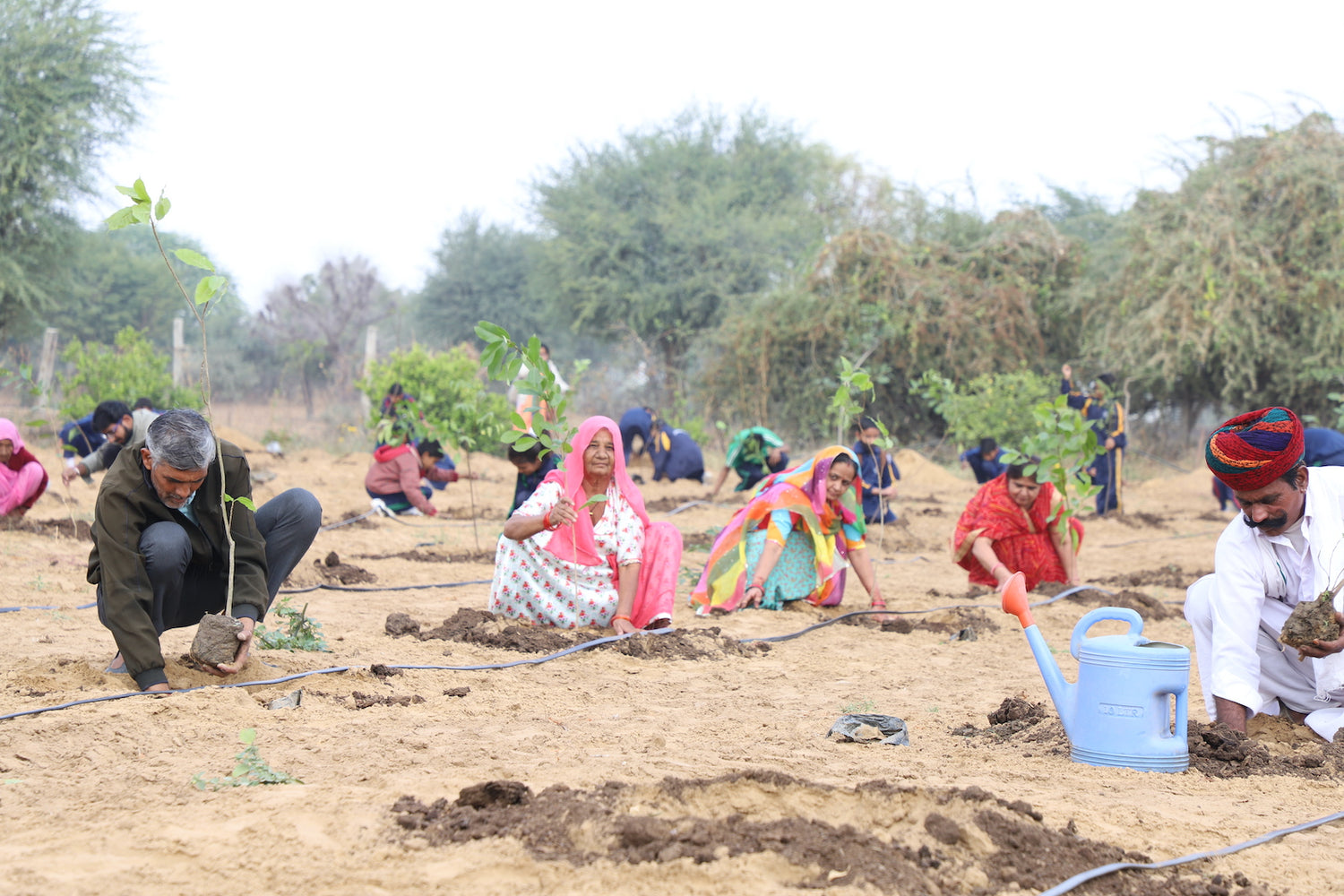Carbon Credit Project: Steps to Launch and Monetize
Carbon Credit Project: Steps to Launch and Monetize 🌍💰 In recent years, carbon credit projects have gained significant traction as a means to combat Read more
Connect with us
-
👥 Corporates
If you are looking for:
- 🌲 Tree Plantation Events
- 📊 CSR Projects
📧 corporate@growbilliontrees.com
📞 +91 9699723523
💬 +91 9325931304 WhatsApp (Only)
🕒 Mon - Sat | 10am - 7pm IST
-
🧩 Tree Plantation NGOs
If you are looking for:
- 💰 Financial Assistance
- 🤝 Operational Support
📧 support@growbilliontrees.com
📞 +91 9699723523
💬 +91 9325931304 WhatsApp (Only)
🕒 Mon - Sat | 10am - 7pm IST
-
🌼 Individuals
If you are looking for:
- 👥 Group Tree Plantation Drive
- 🌳 Bulk Tree Plantation
📞 +91 9699723523
💬 +91 9325931304 WhatsApp (Only)
🕒 Mon - Sat | 10am - 7pm IST
Trending
Trees for Corporates
Carbon Credit Project: Steps to Launch and Monetize 🌍💰
In recent years, carbon credit projects have gained significant traction as a means to combat climate change while providing economic opportunities. This article will guide you through the essential steps to launch and monetize a carbon credit project, backed by scientific data, historical context, and environmental impact. We will also explore how Grow Billion Trees Partners executes and promotes these projects effectively. 🌱
Understanding Carbon Credits
Carbon credits are permits that allow the holder to emit a certain amount of carbon dioxide or other greenhouse gases. One carbon credit is equivalent to one ton of CO2 emissions. The concept emerged from the Kyoto Protocol in 1997, which aimed to reduce global greenhouse gas emissions. 🌐
Steps to Launch a Carbon Credit Project
1. Identify Project Type 🌳
Choose the type of carbon credit project you want to implement. Common types include:
- Reforestation and afforestation
- Renewable energy projects (solar, wind)
- Energy efficiency improvements
- Agricultural practices that reduce emissions
2. Conduct Feasibility Studies 📊
Assess the viability of your project through scientific data analysis. Consider factors such as:
- Location and land use
- Potential carbon sequestration rates
- Community impact and engagement
3. Develop a Project Plan 📝
Create a comprehensive project plan that outlines:
- Objectives and goals
- Budget and funding sources
- Timeline and milestones
4. Register with a Carbon Standard 📜
To monetize your carbon credits, register your project with a recognized carbon standard such as:
- Verified Carbon Standard (VCS)
- Gold Standard
- Climate Action Reserve (CAR)
5. Monitor and Verify Emissions Reductions 🔍
Implement a monitoring plan to track emissions reductions. Third-party verification is crucial for ensuring credibility and marketability of your carbon credits.
6. Market Your Carbon Credits 💼
Once verified, market your carbon credits to potential buyers, including corporations looking to offset their emissions. Utilize platforms like:
- Carbon marketplaces
- Direct sales to companies
- Partnerships with NGOs
Environmental Impact of Carbon Credit Projects 🌿
Carbon credit projects can significantly reduce greenhouse gas emissions, contributing to global climate goals. For instance, a study by the World Bank indicated that carbon markets could potentially reduce emissions by 1.5 billion tons annually by 2030. 🌎
Moreover, reforestation projects not only sequester carbon but also enhance biodiversity, improve soil quality, and support local communities. Fun fact: A single mature tree can absorb approximately 48 pounds of CO2 per year! 🌳
Grow Billion Trees Partners: Execution and Promotion 🌟
Grow Billion Trees Partners is at the forefront of executing and promoting carbon credit projects in various regions. Their approach includes:
- Community Engagement: Involving local communities in project planning and execution to ensure sustainability and support.
- Partnerships: Collaborating with governments, NGOs, and private sectors to enhance project reach and impact.
- Education and Awareness: Promoting the benefits of carbon credits and environmental conservation through workshops and campaigns.
By leveraging these strategies, Grow Billion Trees Partners not only contributes to carbon reduction but also fosters economic growth and environmental stewardship. 🌍💚
Conclusion
Launching and monetizing a carbon credit project is a multifaceted process that requires careful planning, execution, and marketing. By following the outlined steps and learning from successful partners like Grow Billion Trees, you can contribute to a sustainable future while generating economic benefits. Together, we can make a difference! 🌱✨
You may like
Carbon Credit Basics
Understanding the ABCs of carbon credits is like learning the rules of a game before you play. You wouldn’t jump into Monopoly without knowing about Boardwalk and Park Place, right? Carbon credits are essentially permits that allow the holder to emit a certain amount of carbon dioxide. The more you know, the better you can navigate the green maze of sustainability.
Tree Planting Techniques
Think of tree planting as the ultimate DIY project, but instead of a Pinterest board, you’re creating a mini-forest. From selecting the right species to ensuring they have enough space to grow, mastering tree planting techniques is crucial. It’s not just about digging a hole; it’s about creating a thriving ecosystem that can help you cash in on those carbon credits.
Project Development Phases
Launching a carbon credit project is like planning a wedding—there are phases, timelines, and a lot of details to manage. From initial brainstorming to the grand opening of your carbon offset venture, understanding each phase ensures you don’t end up with a cake that’s all icing and no substance.
Regulatory Compliance
Navigating the regulatory landscape is like trying to find your way through a corn maze—confusing and full of twists and turns. Compliance with local and international regulations is essential to ensure your carbon credit project doesn’t end up in a legal pickle. Stay informed, or you might find yourself in a bureaucratic Bermuda Triangle.
Market Analysis
Conducting a market analysis for your carbon credit project is akin to checking the weather before a picnic. You want to know if it’s sunny or if you’ll need an umbrella. Understanding market demand, pricing trends, and potential buyers will help you position your project for success and avoid any unexpected downpours.
Monetization Strategies
Monetizing your tree project is like finding the secret sauce in a recipe. It’s not just about planting trees; it’s about figuring out how to turn those trees into cash. From selling carbon credits to exploring eco-tourism, there are multiple avenues to explore. Get creative, and you might just discover a goldmine in your backyard.
Stakeholder Engagement
Engaging stakeholders is like hosting a dinner party where everyone has a seat at the table. You want to ensure that local communities, investors, and environmental groups feel included and valued. The more you involve them in your carbon credit project, the more likely they are to support your efforts and help you succeed.
Monitoring and Reporting
Think of monitoring and reporting as the fitness tracker for your carbon credit project. You need to keep tabs on your trees’ growth and carbon sequestration to ensure you’re meeting your goals. Regular updates and transparent reporting will keep your stakeholders happy and your project on track.
Sustainability Practices
Implementing sustainability practices is like adding a cherry on top of your eco-friendly sundae. It’s not just about planting trees; it’s about ensuring that your project is sustainable in the long run. From using organic fertilizers to promoting biodiversity, these practices will enhance your project’s credibility and appeal.
Community Involvement
Getting the community involved in your carbon credit project is like inviting your neighbors to help build a treehouse. It fosters a sense of ownership and pride, making your project more resilient. Plus, who doesn’t love a good community event? It’s a win-win for everyone involved.
Long-term Impact Assessment
Assessing the long-term impact of your project is like checking the score after a game. You want to know if your efforts are paying off and how you can improve. Regular assessments will help you understand the ecological benefits of your project and ensure you’re on the right path to success.
Corporate Plantations
FAQ
What is a Carbon Credit Project?
A carbon credit project is like a superhero for the environment, helping to reduce greenhouse gases. It generates carbon credits by implementing eco-friendly practices, which can be sold to companies looking to offset their emissions. Think of it as a green ticket to a cleaner planet!
How do I start a Carbon Credit Project?
Starting a carbon credit project is easier than finding a cat video online! First, identify a sustainable initiative, like reforestation or renewable energy. Then, get certified by a recognized standard. Finally, monitor and report your progress. Voilà! You’re on your way to saving the world and making some cash!
What are the steps to launch a Carbon Credit Project?
Launching a carbon credit project involves a few key steps: identify your project type, conduct a feasibility study, choose a certification standard, develop a project plan, and finally, monitor and verify your emissions reductions. It’s like planning a party, but with more trees and fewer balloons!
How do I monetize my Carbon Credit Project?
Monetizing your carbon credit project is like finding a pot of gold at the end of a rainbow! Once you’ve generated credits, you can sell them on carbon markets or to companies needing to offset their emissions. Just remember, the greener your project, the more valuable those credits become!
What are the benefits of a Carbon Credit Project?
The benefits of a carbon credit project are as sweet as a ripe mango! You contribute to environmental sustainability, create a new revenue stream, and enhance your brand’s reputation. Plus, you get to feel like a climate hero while making a positive impact. Who wouldn’t want that
What types of projects qualify for carbon credits?
Projects that qualify for carbon credits are as diverse as a box of chocolates! They include reforestation, renewable energy, energy efficiency, and waste management initiatives. If it reduces greenhouse gas emissions, it’s likely a contender for those coveted credits. Just make sure it’s certified!
How long does it take to launch a Carbon Credit Project?
Launching a carbon credit project can take anywhere from a few months to a couple of years. It’s like waiting for a fine wine to age! The timeline depends on project complexity, certification processes, and regulatory requirements. Patience is key, but the rewards are worth the wait!
What are the costs associated with a Carbon Credit Project?
The costs of a carbon credit project can vary widely, like the price of avocado toast! You’ll need to budget for project development, certification fees, monitoring, and verification. While it may seem steep, remember that the potential revenue from selling carbon credits can make it a worthwhile investment!
How do I find buyers for my carbon credits?
Finding buyers for your carbon credits is like dating in the digital age—there are plenty of options! You can connect with companies directly, join carbon exchanges, or work with brokers. Networking at environmental conferences can also help you find that perfect match for your credits!
What regulations should I be aware of?
Navigating carbon credit regulations can feel like deciphering a secret code! Each country has its own rules, so it’s crucial to research local laws and international standards. Compliance is key to ensuring your project is recognized and your credits are marketable. Don’t skip the fine print!
Can I combine multiple projects for carbon credits?
Absolutely! Combining multiple projects for carbon credits is like creating a supergroup of eco-initiatives. Just ensure each project meets certification standards and contributes to emissions reductions. This approach can diversify your revenue streams and amplify your impact. More projects, more credits, more fun!
What happens if my Carbon Credit Project fails?
If your carbon credit project fails, don’t panic! It’s not the end of the world, just a plot twist in your green journey. You can learn from the experience, pivot your strategy, or even start anew. Remember, every setback is a setup for a comeback in the world of sustainability!























